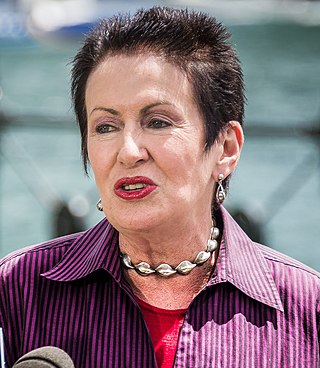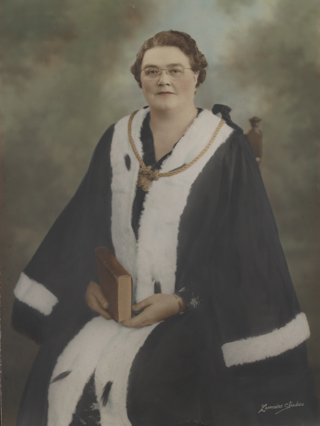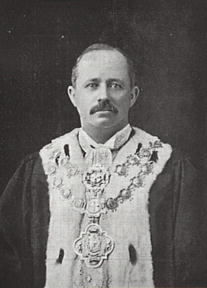
John Joseph Cahill, also known as Joe Cahill or J. J. Cahill, was a long-serving New South Wales politician, railway worker, trade unionist and Labor Party Premier of New South Wales from 1952 to his death in 1959. Born the son of Irish migrants in Redfern, New South Wales, Cahill worked for the New South Wales Government Railways from the age of 16 before joining the Australian Labor Party. Being a prominent unionist organiser, including being dismissed for his role in the 1917 general strike, Cahill was eventually elected to the Parliament of New South Wales for St George in 1925.

Clover Margaret Moore is an Australian politician. She has been the Lord Mayor of the City of Sydney since 2004 and is currently the longest serving Lord Mayor of Sydney since the creation of the City of Sydney in 1842. She was an independent member of the New South Wales Legislative Assembly from 1988 to 2012, representing the electorates of Bligh (1988–2007) and Sydney (2007–2012). Her "recurrent motif" is described as "making Sydney more liveable for individuals and families". Moore is the first popularly elected female Lord Mayor of Sydney.

The City of Canterbury was a local government area in the Inner South-West region of Sydney, New South Wales, Australia. The council area was within the northern part of the Parish of St George above Wolli Creek and The M5 but below The Cooks River. The city was primarily residential and light industrial in character, and was home to over 130 nationalities. With a majority of its residents being born overseas, the council marketed itself as the "City of Cultural Diversity." First incorporated as the Municipality of Canterbury in 1879, the council became known as the City of Canterbury in 1993.

Waverley Council is a Local government area in the eastern suburbs of Sydney, in the state of New South Wales, Australia. First incorporated on 16 June 1859 as the Municipality of Waverley, it is one of the oldest-surviving local government areas in New South Wales. Waverley is bounded by the Tasman Sea to the east, the Municipality of Woollahra to the north, and the City of Randwick in the south and west. The administrative centre of Waverley Council is located on Bondi Road in Bondi Junction in the Council Chambers on the corner of Waverley Park.

John Percival Tate was an Australian architect, urban planner and politician. He was born in New Zealand where he trained as an architect and engineer. He moved to Sydney as a young man and went into private practice, later working for the federal government during World War II. Tate served on the Ryde Municipal Council and Sydney City Council in the 1940s and 1950s. As chairman of the Cumberland City Council he was a key figure behind the Cumberland Plan for Greater Sydney. He also served as a Senator for New South Wales from 1950 to 1953, representing the Liberal Party.

Elizabeth Lilian Maud Fowler MBE, JP was an Australian politician. She was Australia's first female mayor, serving as mayor of Newtown, New South Wales, from 1937 to 1939. She later represented the seat of Newtown in the New South Wales Legislative Assembly from 1944 to 1950. She had a long involvement with the Lang Labor faction of the Australian Labor Party (ALP), which had evolved into a separate party by the time of her election to Parliament.
John Michael Alfred McMahon was an Australian politician and a member of the New South Wales Legislative Assembly from 1950 until 1968. He was a member of the Labor Party and held ministerial positions including Minister for Transport and Minister for Lands.
Thomas Vernon Ryan was an Australian politician. He was a Labor Party member of the New South Wales Legislative Assembly from 1956 to 1965, representing the electorate of Auburn.

Sir Allen Arthur Taylor was an Australian businessman and New South Wales state politician who was Lord Mayor of Sydney, Mayor of Annandale and a member of the New South Wales Legislative Council.

William Neville Harding was a Taxation accountant, company director and New South Wales local government politician who was Lord Mayor of Sydney and an Alderman of the Sydney City Council from 1935 to 1948.

The Municipality of Waterloo was a local government area of Sydney, New South Wales, Australia. The municipality was proclaimed on 16 May 1860 and, with an area of 3.4 square kilometres, included the modern suburbs of Waterloo, Zetland and Rosebery. The suburb of Alexandria was originally included as the Western Ward of the council but seceded as a separate municipality in 1868. After several attempts to amalgamate with various neighbours in the mid-1920s, the council was amalgamated with the City of Sydney, along with most of its neighbours, with the passing of the Local Government (Areas) Act 1948, although parts of the former council area were transferred in 1967 to the City of South Sydney.
A referendum concerning the reform of the New South Wales Legislative Council was put to New South Wales voters on 13 May 1933 and was passed by the voters with a margin of 2.94%. The text of the question was:
Do you approve of the Bill entitled "A Bill to reform the constitution and alter the Powers of the Legislative Council; to reduce and limit the number of Members of the Legislative Council; to reconstitute the Legislative Council in accordance with the reformed constitution; to amend the Constitution Act, 1902, and certain other Acts; and for purposes connected therewith."
The 1941 Sydney City Council election was held on 6 December 1941 to elect councillors to the City of Sydney. The election was held as part of the statewide local government elections in New South Wales, Australia.
The 1944 New South Wales local elections were held on 2 December 1944 to elect the councils of the 301 local government areas (LGAs) in New South Wales.
This is a list of local government area results for the 1944 New South Wales local elections.

The 1944 Kearsley Shire Council election was held on 2 December 1944 to elect eight councillors to Kearsley Shire. The election was held as part of the statewide local government elections in New South Wales, Australia.
The 1947 New South Wales local elections were held on 6 December 1947 to elect the councils of the local government areas (LGAs) in New South Wales.

The 1948 Sydney City Council election was held on 4 December 1948 to elect councillors to the City of Sydney, a local government area of New South Wales, Australia.
Phillip Ward was a ward of the Sydney City Council. It was one of six wards created for the inaugural election in 1842, and was abolished on two separate occasions before its final abolishment when all wards were removed in 1987.













